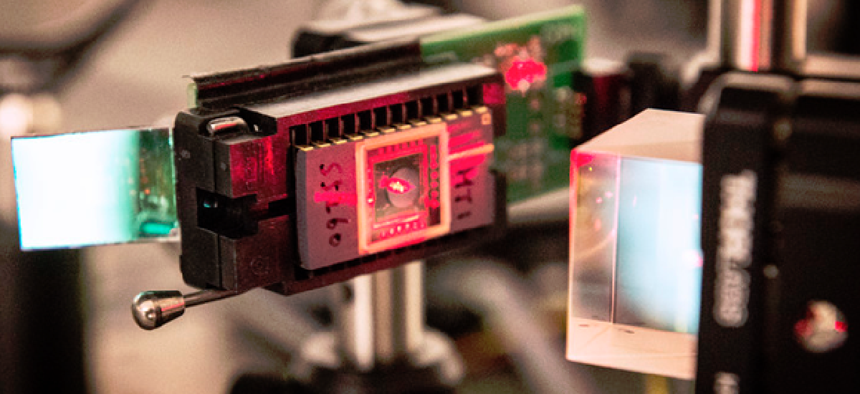Cool, cable-free data centers via laser data transmission

Researchers have demonstrated that infrared lasers can be used to send high-speed, low-error data streams from equipment mounted on top of server racks.
Tell a data center manager that you have a way to get rid of the tangle of wiring that connects the racks of servers and you’ll likely see his or her eyes go wide. Then add that your solution will also slash the costs of keeping the data center cool and you’ll likely hear cries of “Hallelujah!”
FireFly -- an infrared laser transmission system being developed by researchers at Penn State, Carnegie Mellon University and Stony Brook University with support from the National Science Foundation -- just might be the technology that evokes that response.
Yes, FireFly -- which stands for “Free-space optical Inter-Rack nEtwork with high FLexibilitY -- bends the rules for generating compelling acronyms, but it’s unlikely data managers will mind.
In the proof-of-concept system, the researchers have demonstrated that infrared lasers can be used to send bidirectional data streams -- in this case, a television transmission -- at 10 gigabit/sec each way. A receiver captures the infrared transmission and conveys it to a fiber-optic cable on the other end, which delivers the data to a server.
In a real-world implementation, the laser transmitters and receivers would be attached to the tops of server racks because the system requires a direct line-of-sight connection. The transmitter device is equipped with tiny mirrors that can quickly be adjusted to target different receivers connected to different servers.
“A laser can be reconfigured to aim at different targets as a network switch routes traffic bursts of thousands of data packets,” said Mohsen Kavehrad, professor of electrical engineering at Penn State. Just like on a shooting range, he said. “You aim the target and shoot, then turn and shoot the next target.”
What’s more, tests of the system showed that it could deliver the data at high speed and with an excellent error rate, making it suitable for fault-intolerant applications. In fact, according to Kavehrad, initial tests of the system resulted in no errors at all; the team had to decrease power to generate errors.
While the rack-to-rack capabilities of the system have been demonstrated, Kavehrad said the team is also aiming at eventually eliminating the need for fiber-optic connections between the receivers and servers by integrating Airy beam lasers, which can eliminating the line-of-sight requirement. “These are capable of handling many environmental effects such as transient obstacles, misalignments and scintillation,” Kavehrad said.
Data managers will no doubt be happy about simply eliminating the massive amounts of wiring that currently tangle data centers, but Kavehrad said the added bonus is that FireFly will also greatly reduce the amount of electricity required to power data centers.
Much of the energy drawn by data centers is used to power racks with idle servers that can’t be shut down because they’re physically wired to servers in use. With FireFly, however, the ease of rerouting data traffic means that idle or underutilized servers can be shut down.
“In comparison to classic wired infrastructure, FireFly … deployment and maintenance is faster and simpler, and it offers dynamic configuration of the network,” Kavehrad said. “Moreover, FireFly links can be used to augment the performance of virtualization techniques that allow load balancing.” He added that recent testing indicates that as much as 33 percent of data center energy costs could be saved through use of FireFly.





